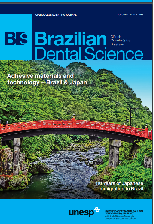Evaluation of the epidemiological profile and oral rehabilitation of patients with buccomaxillofacial trauma
DOI:
https://doi.org/10.14295/bds.2018.v21i2.1509Resumo
Objective: To obtain the epidemiological profile and follow the rehabilitation of patients with buccomaxillofacial trauma attended at a hospital emergency service. Material and Methods: The study consisted of the analysis of medical charts, evaluation and follow-up of adult patients, over 18 years of age, in the preoperative and postoperative period from August 2015 to July 2016. Of the 114 charts examined, all had their epidemiological profile evaluated, but only 45 patients underwent a maxillofacial surgical procedure. During the clinical evaluation, post-trauma conditions were recorded before treatment (T1) and 48 hours after surgical treatment (T2). Results: The age group most affected by buccomaxillofacial trauma was between 20 and 31 years, especially in the male gender. The mandible and nasal bones were the most affected by trauma. The limitation of mouth opening was the main consequence and the levels of buccal opening before and after treatment of mandible fractures were significantly different. Conclusions: The profile of patients with facial trauma was composed of men, aged between 21 and 30 years, motorcycle traffic accidents and physical aggression being the predominant causal factors. The facial bones most affected by the trauma were the jaw and the nasal bones. The limitation of mouth opening was a consequence of the trauma of the mandibular region. Immediate treatment of fractures that affected the mandible provided the restoration of the maximum opening, occlusion and homeostasis of the stomatognathic system in the postoperative patients.
KEYWORDS
Trauma of head; Traumatology; Fracture fixation.
Downloads
Downloads
Arquivos adicionais
Publicado
Como Citar
Edição
Seção
Licença
TRANSFERÊNCIA DE DIREITOS AUTORAIS E DECLARAÇÃO DE RESPONSABILIDADE
Toda a propriedade de direitos autorais do artigo "____________________________________________________________________" é transferido do autor(es) para a CIÊNCIA ODONTOLÓGICA BRASILEIRA, no caso do trabalho ser publicado. O artigo não foi publicado em outro lugar e não foi submetido simultaneamente para publicação em outra revista.
Vimos por meio deste, atestar que trabalho é original e não apresenta dados manipulados, fraude ou plágio. Fizemos contribuição científica significativa para o estudo e estamos cientes dos dados apresentados e de acordo com a versão final do artigo. Assumimos total responsabilidade pelos aspectos éticos do estudo.
Este texto deve ser impresso e assinado por todos os autores. A versão digitalizada deverá ser apresentada como arquivo suplementar durante o processo de submissão.




























